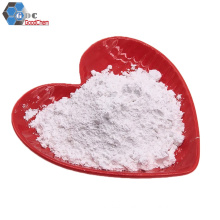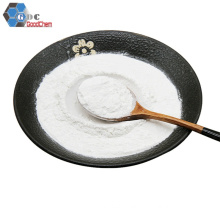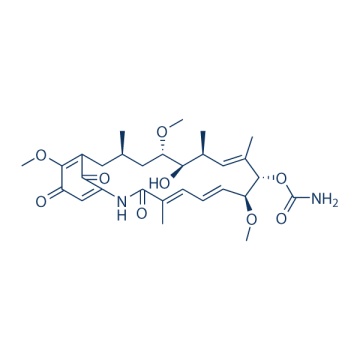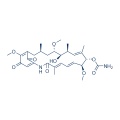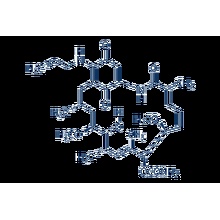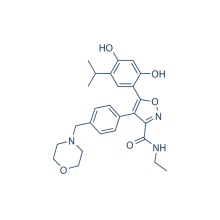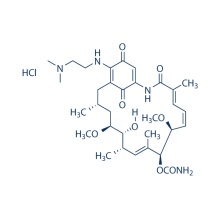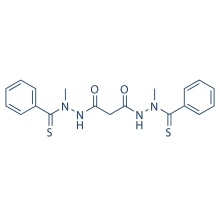.cp_wz tabla {borde superior: 1px sólido #ccc; borde izquierdo: 1px sólido #ccc; } .cp_wz table td {borde derecho: 1px sólido #ccc; borde inferior: 1px sólido #ccc; padding: 5px 0px 0px 5px;} .cp_wz table th {border-right: 1px solid #ccc; border-bottom: 1px solid #ccc; padding: 5px 0px 0px 5px;} \ n Peso molecular: \ n 560.64 La geldanamicina es un inhibidor natural de HSP90 con Kd de 1.2 μM, específicamente altera la asociación del receptor de glucocorticoides (GR) / HSP. \ n Actividad biológica La geldanamicina se une al ATP- sitio de unión en el dominio N-terminal de Hsp90s (residuos 1-220). La geldanamicina inhibe la actividad ATPasa de Hsp90 de una manera dependiente de la dosis. La geldanamicina provoca una detención de G2 dependiente de la dosis y una inhibición reversible de la entrada en la fase S en la línea celular de ovario humano A2780. Esta inhibición se acompaña de un aumento de p53 y finalmente se demuestra que es dependiente de p53. La geldanamicina causa poliubiquitinación y degradación proteasomal de la proteína tirosina quinasa del receptor p185 y muestra una CI50 con 70 nM. La geldanamicina es un reactivo antitumoral típico, muestra un GI50 medio con 0,18 µM frente al panel de 60 líneas de células tumorales humanas. La geldanamicina (50 mg // kg) muestra una inhibición del 30% sobre los niveles de fosfotirosina asociados a pl85 en ratones FRE / erbB-2. Protocolo (solo como referencia) Ensayo de quinasa: [1]
|
Isothermal Titration Calorimetry (ITC) of Nucelotide Binding
|
The titration experiments are performed using the MSC system. In each experiment, 16 aliquots of 15 μL of geldanamycin (300 μM in 1% DMSO) are injected into 1.3 mL of protein (31 μM in 20 mMTris-HCl, pH 7.5, 1 mMEDTA) at 25 °C, and the resulting data are fit after subtracting the heats of dilution. Heats of dilution are determined in separate experiments from addition of geldanamycin into buffer and buffer into protein. No evidence for binding of DMSO in the nucleotide binding site is observed. Titration data are fit using a nonlinear least-squares curve-fitting algorithm with three floating variables: stoichiometry, binding constant (Kb) 1/Kd), and change of enthalpy of interaction (ΔH°). Dissociation constants estimated for geldanamycin binding to intact yeast Hsp90 is 1.22 μM, and for binding to Hsp90 N-terminal domain is 0.78 μM. No meaningful heat is observed with binding to the C-terminal fragment.
|
|
ATPase Assay
|
The ATPase assay is based on a regenerating coupled enzyme assay in which the phosphorylation of ADP by pyruvate kinase at the expense of phosphoenolpyruvate is coupled to the reduction of the resulting pyruvate by lactate dehydrogenase at the expense of
|
Ensayo celular: [2]
|
Cell lines
|
A2780 human ovarian cell line
|
|
Concentrations
|
0.001-10 μM
|
|
Incubation Time
|
3 hours
|
|
Method
|
Exponentially growing cells are treated with Geldanamycin and at various times DNA synthesis is assessed by incorporation of bromodeoxyuridine (BrdUrd) and flow cytometric analysis. No marked difference in total cell number is noted during this time course for treated and untreated cultures. BrdUrd (10 μM) is incorporated over a 4-h incubation period at 37 °C and cells are harvested and fixed in 70% ethanol. After denaturation of the DNA with 2 N HC1, cells are incubated with an anti-BrdUrd mouse monoclonal antibody followed by a fluorescein isothiocyanate (FITC)-linked goat anti-mouse IgG. Cells are stained for 30 minutes at room temperature with propidium iodide and analysed by flow cytometry using a Coulter EPICS Profile Analyzer.
|
Estudio con animales: [6]
|
Animal Models
|
FRE/erbB-2 tumors in nu/nu mice
|
|
Formulation
|
Geldanamycin is dissolved in DMSO.
|
|
Dosages
|
50 mg/kg
|
|
Administration
|
Administered via i.p.
|
Conversión de diferentes modelos de animales basados en BSA (valor basado en datos del Borrador de Directrices de la FDA)
|
Species
|
Baboon
|
Dog
|
Monkey
|
Rabbit
|
Guinea pig
|
Rat
|
Hamster
|
Mouse
|
|
Weight (kg)
|
12
|
10
|
3
|
1.8
|
0.4
|
0.15
|
0.08
|
0.02
|
|
Body Surface Area (m2)
|
0.6
|
0.5
|
0.24
|
0.15
|
0.05
|
0.025
|
0.02
|
0.007
|
|
Km factor
|
20
|
20
|
12
|
12
|
8
|
6
|
5
|
3
|
|
Animal A (mg/kg) = Animal B (mg/kg) multiplied by
|
Animal B Km
|
|
Animal A Km
|
Por ejemplo, para modificar la dosis de resveratrol utilizada para un ratón (22,4 mg / kg) a una dosis basada en el BSA para una rata, multiplique 22,4 mg / kg por el factor Km para un ratón y luego divida por el factor Km para una rata. Este cálculo da como resultado una dosis equivalente para ratas de resveratrol de 11,2 mg / kg.
|
Rat dose (mg/kg) = mouse dose (22.4 mg/kg) ×
|
mouse Km(3)
|
= 11.2 mg/kg
|
|
rat Km(6)
|
Información química
|
Molecular Weight (MW)
|
560.64
|
|
Formula
|
C29H40N2O9
|
|
CAS No.
|
30562-34-6
|
|
Storage
|
3 years -20℃Powder
|
|
6 months-80℃in solvent (DMSO, water, etc.)
|
|
Synonyms
|
NSC 122750
|
|
Solubility (25°C) *
|
In vitro
|
DMSO
|
100 mg/mL
heating
(178.36 mM)
|
|
Water
|
<1 mg/mL
(
|
|
Ethanol
|
<1 mg/mL
(
|
* <1 mg/ml means slightly soluble or insoluble.
* Please note that Selleck tests the solubility of all compounds in-house, and the actual solubility may differ slightly from published values. This is normal and is due to slight batch-to-batch variations.
|
|
Chemical Name
|
2-Azabicyclo[16.3.1]docosa-4,6,10,18,21-pentaene-3,20,22-trione, 9,13-dihydroxy-8,14,19-trimethoxy-4,10,12,16-tetramethyl-, 9-carbamate
|
Calculadora de molaridad Calculadora de dilución Calculadora de peso molecular
Grupos de Producto : Señalización citoesquelética > Inhibidor de HSP

